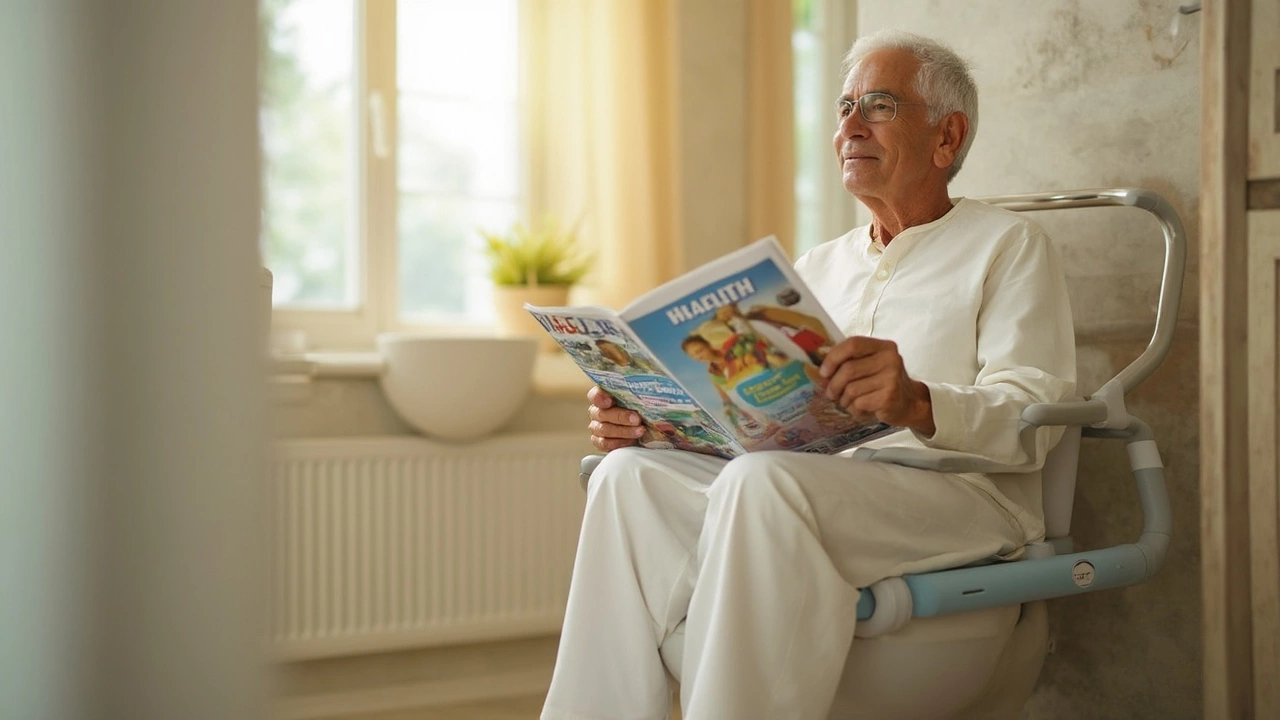If you just had knee replacement surgery and now your bowels have decided to go on strike, you’re not alone. A lot of folks deal with painful constipation or bathroom struggles after knee surgery, but almost nobody brings it up—until nature calls and things get complicated fast.
Between pain meds, moving around less, and your usual bathroom routine changing, it’s almost like your body is working against you. Missing the “go” feeling, straining, or fearing you might twist your knee just trying to wipe—it’s all real. But you don’t have to tough it out. There are simple fixes and workarounds that can spare you a lot of frustration and pain.
Let’s get into practical, no-nonsense tips that really help. You’ll get ideas for handling constipation, making your bathroom setup safer, and doing things that protect your new knee while you handle business. It’s not glamorous stuff, but you’ll be glad you read it the next time you’re in the bathroom and things finally move the way they should.
- Why Is Pooping Hard After Knee Surgery?
- Constipation Fixes: What Actually Works
- Making the Bathroom Safe and Comfy
- Bathroom Habits for Easy Recovery
Why Is Pooping Hard After Knee Surgery?
If you just got a new knee, you might be shocked by how something as basic as pooping can become a big challenge. There are a few reasons behind this, and it’s not just in your head. Actually, it’s super common after knee replacement surgery.
First, those painkillers—especially opioids—are infamous for slowing down your gut. They relax everything, not just the pain. That can make your bowels sluggish, which means you’re much more likely to get constipated. According to a study from the Hospital for Special Surgery in New York, more than 40% of people taking opioids after knee surgery report constipation within the first week.
“Constipation is a frequent concern after orthopedic procedures because pain medications reduce bowel motion, and lower mobility makes matters worse,” says Dr. Lisa Mandl, rheumatologist at HSS.
Lack of movement is another big problem. Walking around is one of the best ways to keep your insides chugging along. After knee replacement surgery, you're moving less, maybe lying around for most of the day. That leads to—you guessed it—poop traffic jams.
On top of that, dehydration is a sneaky culprit. Hospitals aren’t exactly pushing water bottles on you, and during recovery, you might avoid drinking much because you don’t want to get up often (seriously, it hurts!). Less water means harder, slower poop.
Pain itself adds to the drama. Straining to go can actually tweak your new knee and cause more swelling or pain. The fear of messing up your surgery puts extra stress on you, which doesn't exactly help when you need to relax and let things happen.
To sum it up, struggling with bowel movement after knee surgery is a perfect storm of pain meds, low movement, dehydration, and fear of messing up your knee. Understanding all these can help you plan your attack and finally get things moving again.
| Common Factors | How They Affect Pooping |
|---|---|
| Pain Meds (Opioids) | Slow down the bowels |
| Lack of Movement | Bowels get sluggish |
| Dehydration | Hard, dry stool |
| Pain & Anxiety | Harder to relax & go |
Constipation Fixes: What Actually Works
First things first—constipation after knee replacement isn’t just annoying; it can actually slow down your recovery. Opioid pain meds, less movement, and dehydration are some of the main culprits. But here’s the good news: there are a bunch of ways to fix this without making things worse for your new knee.
- Hydration is king: People often forget to drink enough water while stuck on the couch. Aim to sip water all day—about 2 liters (eight 8-ounce cups) is a sweet spot for most adults. Don’t chug, just keep it steady.
- Fiber is your friend: Simple fixes like oat porridge for breakfast, snacking on a pear, or adding a couple of handfuls of berries will up your fiber. You’re aiming for at least 25-30g a day. Too much at once can bloat you, so go slow.
- Stool softeners work: Over-the-counter stool softeners like docusate sodium can make things way easier, and doctors often suggest starting them right after surgery. Don’t wait until you’re already blocked up.
- Don’t skip laxatives: If water and fiber aren’t cutting it, a gentle laxative like polyethylene glycol (MiraLAX) is safe for most people (but check with your doc, especially if you have kidney issues).
- Move when you can: Even wiggling your feet or doing ankle pumps in bed helps your digestion. If your physical therapist tells you to walk to the bathroom, listen to them—it’s good for more than just your knee.
Doctors see this all the time: according to a 2022 study from Cleveland Clinic, almost 40% of people had some level of constipation after joint surgery—and most of them waited too long to fix it. Start these habits as soon as you get home, and you’re way less likely to get bunged up.
| Remedy | Typical Dose | Safe for Daily Use? |
|---|---|---|
| Stool softeners | 100 mg, 1-2 times/day | Yes |
| Polyethylene glycol | 17g powder (1 capful) in water, once/day | Yes |
| Senna (herbal stimulant) | 8.6mg, once at night | Short-term only |
| Fiber supplements | 1 dose (check label) with lots of water | Yes |
The bottom line? Don’t wait for things to get uncomfortable. If you’re on knee surgery recovery and the plumbing isn’t moving, stack up these simple habits—most people see things improve in just a day or two.

Making the Bathroom Safe and Comfy
The last thing you want after knee surgery recovery is to slip or twist something while struggling in the bathroom. So how do you make things easier and less risky? Start with some simple upgrades you can set up before coming home.
You might not realize just how much you rely on your knees to sit, stand, and wipe until you try it on a cranky, post-surgery leg. Groaning from pain or feeling wobbly is common, but you don’t have to white-knuckle through it. Setting up a safe and comfy bathroom will save your sanity—and your new knee.
- Raised toilet seat: This one’s a game changer. Adding a raised seat makes it way easier to sit and stand without bending your new knee too much. Most people find 2-4 inches of extra height is perfect.
- Grab bars: Don’t trust towel racks—install real grab bars next to the toilet. This lets you brace yourself, shift around, or even pull up your pants without risking a fall.
- Non-slip mats: Tile and wet feet don’t mix. A good rubber mat by the toilet means you’re not skating around or suddenly losing your balance.
- Wiping tools: Reaching back can get awkward with stiff knees. You can buy toilet aiding tools, or even use flushable wipes for less twisting.
- Accessible supplies: Keep toilet paper, wipes, and your pain meds within arm’s reach. No need to play fetch while your leg is screaming.
Think all this stuff is overkill? Not really. Hip and knee clinics often report that about 1 out of 4 falls at home happen in the bathroom after surgery—mostly when the setup is awkward or people are hurrying.
| Tool | Average Cost (USD) | Helps With |
|---|---|---|
| Raised toilet seat | $30 - $60 | Bending less, safer sitting/standing |
| Grab bars | $15 - $40/each | Balance, stand support |
| Non-slip mat | $10 - $25 | Preventing bathroom slips |
| Toilet wiping aid | $10 - $30 | Reaching back with less effort |
If possible, set things up so you always sit down slowly and get up with your strong leg first. For early recovery, having a friend help with the setup can make life way less stressful. A little prep now means fewer close calls and a much smoother time when nature calls after your knee replacement.
Bathroom Habits for Easy Recovery
Getting back to normal bathroom habits after knee replacement surgery takes patience—and a few new tricks. The key is to make things easy on your healing knee while also helping those bowels work like they should. Here’s what actually helps:
- Keep a regular bathroom schedule: Don’t just wait until it’s urgent. Try heading to the toilet at the same times every day, like after breakfast when your gut usually wakes up. Staying consistent helps train things to get moving again after surgery.
- Use a raised toilet seat: Sitting lower puts stress on your new knee and makes standing up harder. Most people find a raised seat or toilet frame (cheap, easy to find at drugstores or online) is a total game-changer.
- Lean forward, but not too much: Lean forward slightly with your knees apart to help things move. Don’t hunch so much that you risk losing your balance or stressing the joint. Use your arms on armrests or handles for support if you need to.
- Take your time: Don’t rush or force it. Straining not only hurts your knee, but can actually slow down your bowels. If nothing’s happening in 10-12 minutes, get up and move around a bit before trying again.
- Wipe without twisting: This is awkward at first. Use toilet aids (long-handled wipers or pre-moistened wipes) if you can’t twist comfortably. The less you torque your knee or bend in weird ways, the safer it is.
Your medication routine can really mess with your bowel movement schedule after knee surgery. Opioid painkillers slow things down for most people—about 40% get constipated from their meds. If you have to stay on them, stay proactive: stool softeners, plenty of water, and fiber are your friends.
- Stay hydrated: Drink a glass of water with every meal and snack. This keeps your poop soft and easier to pass—which matters a lot when you want to avoid pushing and straining.
- Get moving (carefully): Walkers, crutches, whatever you have—use them to walk a little every few hours. Just a lap around your living room helps wake up your guts and keeps blood flowing to your leg and knee. Gentle movement also makes you less likely to get blocked up.
It might sound silly, but posture matters. If your doc or therapist said you can, try putting your feet on a low stool in front of the toilet (think squatty potty style) to open things up and make pooping after knee replacement way less of a hassle.
One more thing—set up your bathroom before surgery. Stock it with everything you need in arm’s reach: wipes, handrails, a grabber tool, maybe even a phone if you’re waiting a while. Trust me, scrambling for stuff mid-bathroom-break is no fun on a healing knee.
